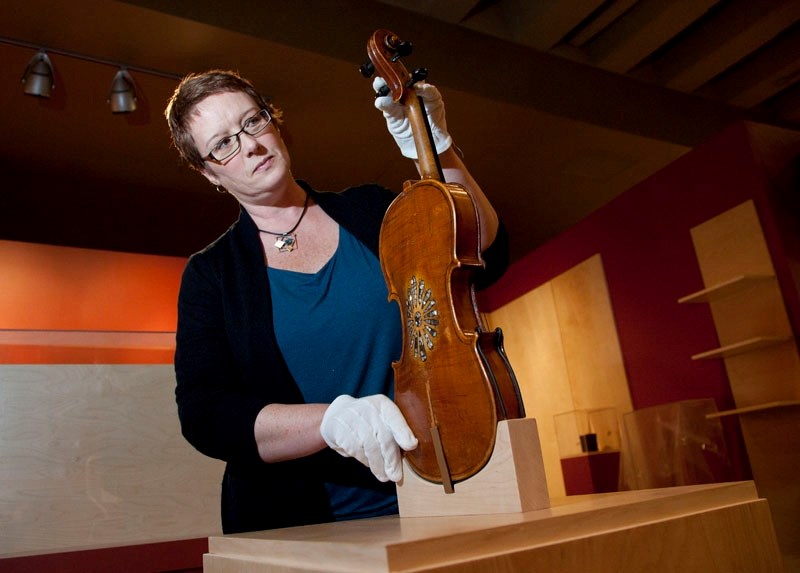St. Albert has 150 years of rich history behind it but what came before that? The Musée Héritage Museum now has the answers in its new History Gallery to be unveiled next week.
The space has been completely redeveloped to include 5,000 years of this area’s past. According to museum staffers, the key was about how the land was used.
“This area has amazing natural resources, both practically and aesthetically,” explained curator Joanne White. “It’s our water and soil and our wildlife that brought people here in the first place, as well as the fact that it’s very scenic and a nice valley to be in.”
Original planning started two years ago but there was so much ground that they wanted to cover and not enough exhibit space. They had to draw a line where the story would stop.
“As we discussed certain subject areas, we thought, ‘OK, we’ll focus on this.’ Then space issues here made us decide we could only cover this amount of material. That was part of the discussion.”
They then focused on the many years before the Northwest Company and Hudson’s Bay Company and other European influences came on the scene.
That pleases lead aboriginal programmer Sharon Morin.
“That’s the part of history in this area that’s not always talked about. There were people here before [the Mission].”
Visitors can expect a chronological sequence of events — the who, what and when of why people came here starting at 3,000 BCE. You will learn that 12,000 years ago it was still covered in a massive ice sheet, making this whole area practically uninhabitable to all life.
When the glacial lake melted, pools and rivers started to dot and dash along this aspen parkland. Big Lake formed with the Sturgeon River running through it. The proximity of so much water meant that the ground surrounding the shores would be fertile. Where plants grow is exactly where the bison would roam to get food. Archaelogical evidence shows that people who lived typically subsistence lifestyles followed suit and the rest, as they say, is history. There were four ancient campsites discovered at the junction of Big Lake and the Sturgeon River, one with a stone tool workshop. The oldest site dates from the Middle Prehistoric Period, about 5,000 years ago.
Our history starts with natural history. The fur trade brought the establishment of commerce and even greater populations of more diverse peoples, like the Cree and Blackfoot.
Those who weren’t involved with trapping for the trade found themselves living with the horse guards for the Northwest Company and the Hudson’s Bay Company. The presence of so many horses extended from the fact that this was a prominent staging point and base for those on the trails to trade points like Fort Augustus and Edmonton House, among others. The area was picking up in the early 1800s.
There were 17 MĂ©tis families who lived near Lac Ste. Anne when the Oblates of Mary Immaculate made a mission there. Several of them moved here with Father Albert Lacombe in 1861. Soon there were 20 families. The next year a wooden bridge was built, a model of which is still a fixture in the gallery.
Other areas will have similar stories but the displays only talk about what makes this area unique. That’s one of the main reasons why the discussion stops at about 1906 when our first grain elevator was built. That’s when our path gained a new mission — agriculture – and the rest of our growth from that point paralleled that of so many other communities.
The gallery was last updated after a major sewage backup in November 2002. Now it isn’t considered permanent anymore. The museum staff intends to change it every few years but the exhibit is flexible enough to allow for specific artifacts to be rotated in and out whenever they choose to do so.
It also gives them the opportunity to focus on individual subjects with more in-house shows that rotate every few months in the other space.
“We always have to make choices as to what the content is. We have hundreds of other pieces in storage that we’d like to display but you have to pick and choose,” White said.
When planning more than two years ago, they put everything on the table. Then they realized that they might have bitten off more than they could chew. They scaled back but still found ways to include some amazing artifacts including the Treaty Medal, a beautiful beaded Cree saddle and a Scottish boy’s waistcoat. The Canadian Museum of Civilization even wanted to borrow the MĂ©tis fiddle but staff declined the loan.
This exhibit will have a major impact on all of the people who visit, not just the history buffs who are employed at the museum.
Morin is excited because of what it means for all of the schoolchildren and others who seek knowledge by studying the past.
“This will really enhance educational programming for schools even more,” she exclaimed. “I just think it’s going to be explained in more of a flow.”
The museum has always made the best use of its space and human resources. Its team of educators brings in an average of two programs each day equalling thousands of attendees each year.
“We do a huge amount of programs here. We had 800 kids here last month.”
It will even help the museum reach into the future as it develops new programs.
“It’s just going to be very beneficial all around.”
Ray Pinco, the chair of the St. Albert Historical Society, will get his first look at the exhibit next Wednesday evening but he’s already very familiar with most of the details. He likes the philosophy behind the show.
“I’m glad that they’re going back to what is normally called pre-history, which is aboriginal occupation. I’m glad that the museum is going to actually tell that story. MĂ©tis occupation in this area has been here a long time.”




